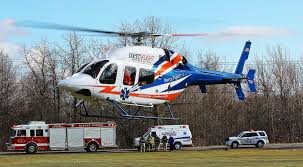Every year critical car transport nurses are honored with a recognition day that highlights the unique challenges and satisfaction of their specialty. Today’s Critical Care Transport Nurses Day, sponsored by the Air & Surface Transport Nurses Association, celebrates nurses in this area of nursing while also spreading awareness of what this job entails.
Critical care transport nurses are part of the healthcare team that helps move critically ill patients quickly and safely while also providing high-quality emergency patient care. And they do this in a moving vehicle–which could be by flight (helicopter) or ground (ambulance).
Like all nurses, critical care transport nurses have to be prepared for any change, but because they are providing care in a moving vehicle they have to add an entire other layer of unpredictability to their daily work. Any nurse knows that things can happen that quickly change the way you are providing care–from the patient’s condition to the facility you are working in. For critical care nurses, they also must consider additional variables such as weather, traffic, and the uncertain situation they may be taking a patient from such as a car crash, a trauma site, or a remote wilderness. In some instances, critical care transport nurses are bringing patients to a different facility for life-saving treatment.
Although some may see those wildcards as a negative, nurses who are attracted to critical care transport nursing see it as a positive. They are able to use all their nursing skills as well as additional critical thinking, task management, and rapid assessment of the big picture in situations that other nursing roles wouldn’t provide.
Critical care transport nurses are also on the move in their role. Given the fluctuations in the terrain, situation, and care needed, nurses may be required to climb or run and will need to have the ability to lift and carry patients in varied situations. They will need to maintain a focus on the patient as they move the person from whatever situation they could be in, to the transport vehicle, and then provide a comprehensive hand-off to the care providers at the final facility. The pace is intense and fast.
If you’re interested in this career choice, you’ll gain expertise in patient needs across the age spectrum, including the equipment used for different ages and conditions. For some nurses, a pediatric critical care transport role provides a role within a specific patient population they want to work with. As you gain experience, you’ll adapt to your working environment and will be able to provide care through changing conditions and while relying on your team members.
Nurses in this specialty should aim for certification as they need to keep updated on their emergency nursing skills and using those skills within specific transport vehicles. The Board of Certification for Emergency Nursing offers certification for a Certified Flight Registered Nurse or a Certified Transport Emergency Nurse, as well as trauma and emergency certifications.
If you’re a critical care transport nurse, take today to celebrate and enjoy the challenges of this meaningful work.
- WOC Nurses Week Highlights Specialty - April 16, 2024
- Honoring Radiology Nurses Day on April 12 - April 12, 2024
- Travel Offers New Career Possibilities - April 8, 2024



